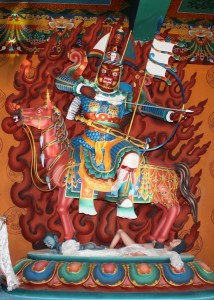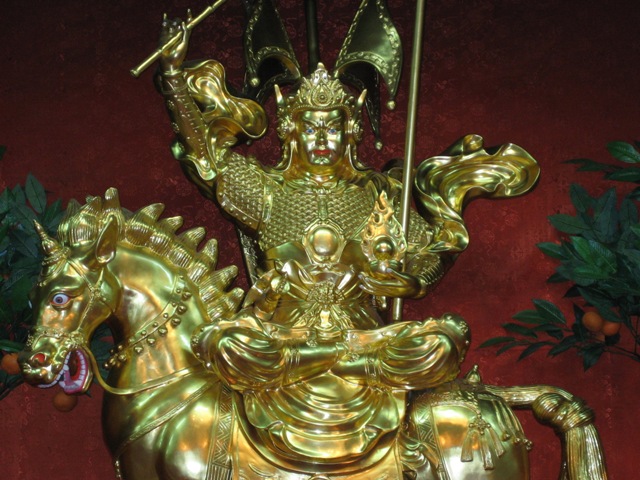Monday
Featured StoriesWrathful Gesar
By Walker Blaine
His Eminence Namkha Drimed Rinpoche will bestow the empowerment of Gesar Trakpo, Wrathful Gesar, on the Shambhala and Ripa vajrayana sanghas during two-day program on November 7th and 8th in Halifax, Nova Scotia. The Gesar Trakpo practice is new to our community; this is the first time the empowerment will be bestowed in Shambhala. Sakyong Mipham Rinpoche requested His Eminence to grant this empowerment from His Eminence’s own terma collection. Gesar Trakpo is the wrathful manifestation of warriorship, the embodiment of the wisdom that engages the deepest aspects of ego and materialism through fearless compassion.
Generally speaking, Gesar is known to us as a historical figure, as an ancestral sovereign providing inspiration to the Shambhala lineage and as the central figure in bardic folk songs of Tibetan culture. The bardic tradition of Gesar is important both because of its function as heroic inspiration and as a means to publically transmit the practice and culture of Dzogchen in much the same way that the Milarepa songs and stories publically share the Mahamudra tradition. Gesar’s appearance as a warrior king during a time of great negativity and cultural degradation in Tibetan history is a parallel to the emergence of Shambhala in these times of speed and materialism.
The practices of Gesar are a means to quickly attain the state of a warrior’s mind that unhesitatingly achieves the benefit of others. The Gesar Trakpo practice will serve as an occasional liturgy for our vajrayana sangha. There is a rich tradition of practices related to Gesar Trakpo, which is as developed as the Kagyu and Nyingma yidams already established in our community. The full form of Gesar Trakpo will be practiced during short end-of-year intensives leading up to Shambhala Day. A condensed Gesar Trakpo liturgy will be offered at the empowerment to be used like the other short practices available to the vajrayana sangha. The main yidam practice for Shambhala will remain the Werma Sadhana.
Gesar can manifest as a king or guru, as a yidam (meditation deity) or as a protector. Many of us are already familiar with the short Gesar protector chant, and we all know Gesar very well in his role as a dharma sovereign. Gesar manifests as a yidam such as Gesar Trakpo in the same way that the Buddha Shakyamuni manifested as the deity Kalachakra when he taught the vajrayana to Dawa Sangpo, the first dharma sovereign of Shambhala. Gesar Trakpo is analogous to Dorje Trollo, the wrathful manifestation of compassion that Padmasambhava assumed when he first entered the untamed land of Tibet.
This abhisheka will occur in the two days prior to the Shambhala Congress and be received by members of the Shambhala community from all over the world. The empowerment will further establish the connection between the energy of Gesar and the Shambhala community, and it will deepen our relationship with His Eminence and the practice lineage that he holds. The introduction of a wrathful practice in the community at this time is also meant to support the Sakyong’s year-long retreat in the same way as the Tenshuk and the preparatory practices that have been done in Asia and the west. To learn more about the Tenshuk, click here.
Watch a video about the Gesar Shrine room at Rigon Thupten Mindolling in Orissa, India.
It is the Sakyong’s wish that all Dorje Kasung receive the Gesar Trakpo empowerment and that the liturgy gradually become a part of our yearly practice cycle. Receiving this abhisheka will be a requirement to do this practice in Shambhala. His Eminence will be requested to bestow the empowerment at other centers in the near future. For those wishing to learn more about the Gesar Trakpo empowerment and the Shambhala Congress in Halifax, click here.
Walker Blaine lives in Halifax, Nova Scotia. He authored the three-month Rinchen Terdzo blog (www.rinchenterdzo.org) and is a member of the Nalanda Translation Committee. His two CDs of dharma songs can be sampled at www.highlandeyes.com, on iTunes and on Rhapsody.



















Nov 13, 2009
Reply
Dear Greg,
There are differences between the Wrathful Gesar sadhana and the Vidyadhara’s Gesar practice. The main difference is that the Vidyadhara’s practice is not a sadhana, but a text that can be inserted in a sadhana. As we receive more Gesar practices I suspect that we’ll learn more about the tradition of Gesar as well as the meaning of elements presented in the Vidyadhara’s text. The Vidyadhara’s practice has Gesar as a protector; it is done along with our usual protector practices. In the Wrathful Gesar practice, Gesar is a yidam, so that’s another difference. Gesar can be practiced as a guru yoga as well. Ju Mipham wrote practices like that, one of which the Sakyong requested be printed for the Gesar Trakpo empowerment.
Gesar is an ancestral sovereign of Shambhala. This gives any Gesar practice a direct connection with the tradition of warriorship and with creating enlightened society. The ancestral sovereigns are a theme that we know well from the Shambhala tradition, but one we haven’t been able to explore much yet. Being an ancestral sovereign is a distiction that sets Gesar apart from yidams that we are more familiar with, like Vajrakilaya. I suspect we’ll see in the coming years more of why the Sakyong asked that wrathful Gesar become part of our practice package. This is the first major yidam practice we’ve welcomed into our community in a long time, and the Sakyong has said it’s not something we do lightly.
In general, Gesar Trakpo is being presented as an elective practice, a personal practice we can do when we feel it is necessary. Later it will be introduced as a don season practice, one we do at the end of the year in short group intensives. Gesar Trakpo isn’t meant to replace the Werma practice or the other sadhanas we’re familiar with. This is approach to a sadhana is new for us although older students know it from practices like Jambhala, which is an elective sadhana not meant to replace one’s main practice.
During the empowerment weekend, His Eminence stressed that Gesar Trakpo was a practice for this time in history when the dharma and virtue in general are faced with many difficulties. He remarked that Gesar Trakpo got to the heart of what Gesar was about in terms of engaging with obstacles. Just as the Scorpion Seal was the beginning of a deeper exploration of the Shambhala Terma, the arrival of Gesar Trakpo seems to present further avenues to explore warriorship, drala, and the meaning of Shambhala Buddhism.
All the best,
Walker Blaine
Nov 3, 2009
Reply
Interesting piece, thanks Walker! This analogy:
“The bardic tradition of Gesar is important both because of its function as heroic inspiration and as a means to publically transmit the practice and culture of Dzogchen in much the same way that the Milarepa songs and stories publically share the Mahamudra tradition.”
was particularly illuminating.
Regarding the Gesar Trakpo empowerment itself, it does seem to have a natural place in the community’s repertoire, but I can’t help but wonder if there isn’t some redundancy created with regard to the Vidyadhara’s Gesar supplication (also bestowed by NDR) which I seem to recall was also intended to dispel obstacles, and perhaps also with Vajrakilaya practice.